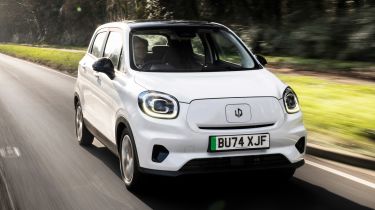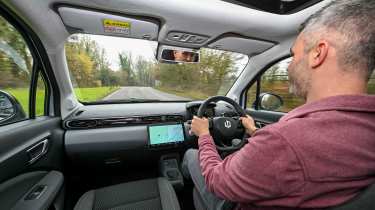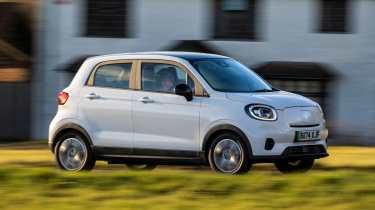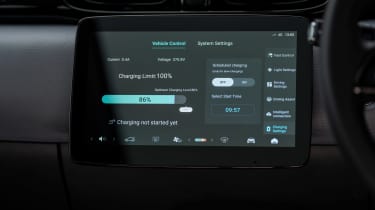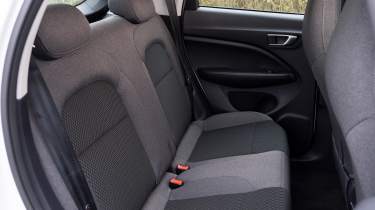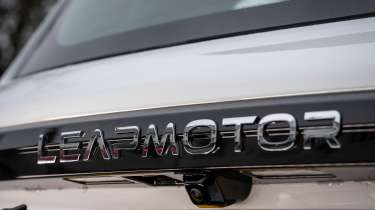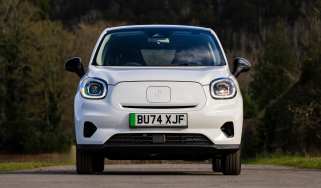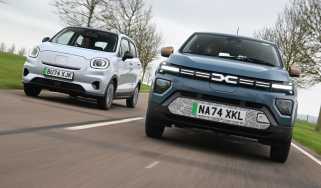Leapmotor T03 review
New brand’s smallest EV offers decent space, strong refinement and great value for money
Our opinion on the Leapmotor T03
With a wave of new brands coming to market in recent months, it can be hard to stand out from the crowd. But the Leapmotor T03 manages to do so by being a small electric city car that’s packed with kit and all for a competitive price. It’s not without its flaws, but when it’s priced so low and features so much standard equipment, it’s easy to overlook the foibles of its intrusive safety systems and the frustrating infotainment touchscreen. The refined driving experience also goes a long way to making up for its shortcomings elsewhere.
About the Leapmotor T03
While Leapmotor is a new brand to UK customers, it benefits from being a part of the wider Stellantis group, so it has piggybacked on sister brands to fast-track its UK dealer network, with around 80 franchises due to be open before the end of 2025.
The Leapmotor T03 is the smallest car that the company sells – it’s joined by the B10 and C10 electric SUVs in the line-up – and it’s also one of the cheapest cars currently for sale in the UK, with list prices starting from £16,000 before any discounts have been applied.
For the money you get a compact five-door city car with a four-seat interior, plus a long list of equipment. There’s just one model offered, but it comes with the sort of kit that you’d be happy to get in a car costing twice as much. There’s keyless entry, a panoramic glass roof, a reversing camera, a 10-inch touchscreen, a multifunction steering wheel and a host of safety systems.
Leapmotor T03 prices and latest deals
While a £16,000 asking price is already impressive, there are even greater savings to be had courtesy of some competitive discounts that are on offer direct from Leapmotor. You can find out more about these via the Auto Express buy a car service, where you can get behind the wheel from around £260 a month.
Performance & driving experience
Pros |
|
Cons |
|
For such a d, the T03 feels surprisingly grown-up and refined to drive, but the overly intrusive driver-assist systems are infuriating.
| Model | Power | 0-62mph | Top speed |
| Leapmotor T03 | 94bhp | 12.7 seconds | 81mph |
Electric motor, 0-60mph acceleration and top speed
A simple car needs a simple powertrain structure, which explains why there’s just the one option in the T03. A single motor drives the front wheels, and its output of 94bhp and 158Nm is pretty healthy for such a small car.
While those numbers comfortably out-punch the Dacia Spring, the Leapmotor does weigh more, too. At 1,175kg, its kerbweight is closer to most typical superminis than city cars, but it’s still significantly lighter than the majority of EVs on the market, which as we’ll see later, bodes well for its efficiency.
On the road, that motor delivers more than enough punch for a car like this; around-town acceleration is great, and is better than the most powerful Dacia Spring that’s offered. Acceleration does tail off towards motorway speeds, but it’s still perfectly adequate for the occasional longer high-speed trip.
The powertrain itself is a little more finely tuned than the Spring’s, particularly at parking speeds. However, we found the fact that the drive mode settings default to Eco whenever the car is restarted – rather than being left in the mode the driver had last chosen – to be a little irritating.
Town driving, visibility and parking
Once you’ve got over the slightly odd noise emitted by the pedestrian warning tone – the tune ramps up its pitch in noticeable steps, which makes it sound like it’s playing a sci-fi tune as it drives along – the T03 delivers an impressively mature and sophisticated driving experience.
There’s little of the tinny, slightly flimsy feel of the Dacia Spring on the move, with the overall refinement feeling at least on a par with many models from the class above. Vehicles this small tend to feel a little bouncy over bumps, but even here the T03 feels more stable than many other similarly sized alternatives, including the Kia Picanto.
As with the Spring, the Leapmotor is fantastic to manoeuvre in tight spaces; officially, the T03’s turning circle is 7cm larger than its Romanian rival’s, but a figure of 9.7 metres is still great.
Country road driving and handling
At higher speeds, that steering can feel a little odd, however. While it’s not as remote as the Dacia Spring’s rack overall, it’s quite vague and has a reasonable amount of play around the straight-ahead, with an unnatural urge to self-centre itself.
Apply more lock through a corner, and that weighting still feels a little off, but given that the Leapmotor is almost never going to be pushed hard, this isn’t the end of the world. Neither is the fact that the T03 feels a little dull to drive; most city cars and superminis feel sprightly and fun, but the Leapmotor seems rather flat-footed in comparison. Again, this isn’t a massive issue for a vehicle in this segment, and the fact that it’s stable and predictable is good enough.
Motorway driving and long-distance comfort
That overall sense of refinement and stability continues on faster roads, too. Given the tall, narrow body, the Leapmotor might look as if it would be susceptible to crosswinds, but it’s more planted at speed than the Spring. There’s more soundproofing, too, so the T03 is impressively hushed at speed. For a car that isn’t really designed for motorway runs, it delivers a solid performance.
"Budget cars are often fitted with budget tyres. The Dacia Spring and the entry-level BYD Dolphin both ride on Linglong tyres, which I find hard to accept even on cheap motors. I was pleasantly surprised, then, that when I tested the Leapmotor T03, our test car was fitted with Continental tyres." - Alex Ingram, Chief reviewer.
Range, charging & running costs
Pros |
|
Cons |
|
A small car with a small battery translates into impressive real-world efficiency and range – and therefore low running costs.
Electric range, battery life and charge time
The T03’s relatively light weight compared with most EVs means it makes great use of the energy you feed it. During a week of mixed driving – including brief forays onto a motorway – it averaged an impressive 4.6 miles/kWh at temperatures of roughly 12 degrees.
That’s slightly less efficient than the even lighter Dacia Spring, but the Leapmotor’s larger battery pack – 36kWh of usable energy to the Spring’s 26.8kWh – translates into 166 miles of real-world range; that’s one mile more than the official claim and a really impressive figure for the cash.
Pop open the charging flap on the nose and plug in a CCS plug at a typical rapid charger, and the Leapmotor T03 is capable of topping up its battery at up to 48kW. That’s fairly modest by modern EV standards, but it’s still quicker than the Dacia Spring’s 30kW maximum.
Given that the battery isn’t that big anyway, it means that a 30-80 per cent charge takes 36 minutes. That means there’s a reasonable wait on a longer trip, but those trips aren’t likely to be very common in a car like this anyway; most T03s will be topped up at home.
| Model | Battery size | Range | Insurance group |
| Leapmotor T03 | 37.3kWh | 165 miles | 25 |
Insurance groups
For a car so small and cheap, group 25 insurance will come as a bit of a surprise to some prospective buyers. For reference, the lowest-grouped Hyundai i10 ranks in the basement group 1.
Tax
Few cars will cost as little on a company car tax scheme as the T03, with standard-rate income tax payers facing annual deductions of just £96 (in 2025/2026). Since the T03 is so cheap, it’s a shame that it now faces the same annual £195 VED road tax charge as any other petrol or diesel car that costs less than £40,000.
Depreciation
The T03 is predicted to maintain just over 45 per cent of its original asking price after three years. That’s a little behind petrol-powered city cars; the Hyundai i10 and Kia Picanto cost slightly more to buy in the first place, but depending on their trim, they hold anything between 50 and 55 per cent of their value from new.
Interior, design & technology
Pros |
|
Cons |
|
The exterior of the Leapmotor T03 is a pretty simple design. There are rounded features to give it a friendly look and Leapmotor says the fake grille was shaped to look like a smile. The proportions are tiny, especially when you see the side profile and the wheels sitting at each corner.
The ‘cell-to-chassis‘ platform is bespoke to the T03 and allows it to have traditional ‘city car’ dimensions, although Leapmotor claims interior space is on a par with what you would normally see in a supermini. With no internal combustion-engined version, there’s greater scope to efficiently pack the electric powertrain within the T03’s body.
Interior and dashboard design
This isn’t a car you come to for an inspiring interior design, because the T03 is fairly plain to look at, even beside budget rivals such as the Dacia Spring. With so many controls located on the touchscreen, which we’ll address later, the cabin remains fairly sparse. The Mercedes-style column-mounted automatic shifter is fairly intuitive, and the steering wheel has a few buttons for trip and audio functions, but it does feel pretty bare.
Materials and build quality
The plastics are hard, which is common with city cars, but there’s nothing that feels overly cheap and nasty inside. It doesn’t look quite as substantial as a Kia Picanto, but it’s perfectly adequate. Fabric sections in the door panels might seem like a simple touch, but they help to lift the feel above some other alternatives at this price.
Infotainment, sat-nav and stereo
For a car so small, Leapmotor has packed the T03 with standard tech. This includes keyless go, electrically adjustable and heated door mirrors, an electronic parking brake, four electric windows, rear parking sensors, adaptive cruise control and even a large panoramic sunroof with an electric blind.
There’s also a digital instrument panel and a 10-inch touchscreen display. The name Leap OS4 suggests this is the fourth iteration of the firm’s in-car software, but we think that the brand needs to go through a couple more heavy updates before the system is in reasonable working order.
There are currently too many irritations. The on-screen menus and keys are far too fiddly, while certain functions, such as the heating controls, are confusing. It feels like Leapmotor has laid things out differently for the sake of it rather than for any ergonomic benefit.
While part of us thinks that we should be grateful that a car so cheap comes with a touchscreen at all, the fact that so many functions are operated through the display means it must be held to a high standard, and it misses the mark.
We rarely approve of confining heating controls to a touchscreen, and here they’re needlessly messy; they’re accessed by a small shortcut key on a bar running along the base of the display, and once the page has been opened, you can choose to either turn on a heater or a cooler, rather than select a simple temperature choice as in almost any other car. Worse still, the headlights are also controlled by the screen. While some might argue that automatic headlights make the need for physical controls less important, automatic units aren’t infallible, and such a fundamental function should be made a priority with physical switches.
If the system deserves credit in one area, however, it’s that the reversing camera is impressively sharp by any standard, let alone on a car this cheap.
The incessant series of bings and bongs from the various safety systems seems unnecessary. This is a familiar complaint about Chinese cars, and is as bad here as in any new model I’ve tested; what should be a help feels more like a hindrance." - Richard Ingram, Deputy editor.
Boot space & practicality
Pros |
|
Cons |
|
At just 3.6 metres long, there are few new cars smaller than the T03. But while it’s tiny, it makes great use of the space it takes up.
| Dimensions comparison | |||
| Model | Leapmotor T03 | Dacia Spring | Hyundai i10 |
| Length | 3,620mm | 3,701mm | 3,670mm |
| Width | 1,652mm | 1,583mm | 1,680mm |
| Height | 1,577mm | 1,519mm | 1,480mm |
| Wheelbase | 2,400mm | 2,423mm | 2,425mm |
| Boot space | 210-880 litres | 308-1,004 litres | 252-1,050 litres |
Proportionally the Leapmotor T03 is more of a conventional city car than the Dacia Spring, while the rounded overall shape is reminiscent of early 2000s cars such as the first-generation Kia Picanto or a Daewoo/Chevrolet Matiz.
Seats & passenger space
Up front, the T03’s cabin feels light and airy, with a deep dash reaching out towards the short bonnet, and just a small console jutting out of the bottom against an otherwise open floor area.
The steering wheel adjusts for height only (not unusual at this price) and while there’s reasonable adjustment in the seat, we were left wishing for a little more support at the sides and from the base cushion. It’s okay for the most part, but on slightly longer trips it starts to become a little less comfortable.
Passenger space in the back is excellent for a car of this size. There’s more space here than you’ll find in other city cars such as a Spring or Picanto, and even some compact SUVs such as the Jeep Avenger. If you regularly carry four adults on short urban trips, few cars fit the bill better.
Boot space
A 210-litre boot capacity is behind its nearest rivals, falling well short of the 308 litres offered by the Spring. While you won’t be squeezing big dogs or bulky items in there, some clever packing should still mean the load bay will offer enough room for a reasonably big supermarket shop.
A pair of adults in the front will be fine for shorter journeys, but you’ll have to be comfortable making close acquaintance with your passenger because there isn’t a huge amount of shoulder room available. This is highlighted by the fact there’s no space made available for a central armrest. - Richard Ingram, Deputy editor
Reliability & safety
Pros |
|
Cons |
|
It’s one thing having safety technology that will pass a controlled lab assessment – and we’ll see how the T03 fares when Euro NCAP tests it – but how the kit works in the real world is another completely.
We’ve complained about the accuracy of speed-limit warning systems in the past – and the T03 isn’t great in this respect, reading the wrong road signs from time to time, too – but it’s the lane-departure warning and lane-keep systems that are the most frustrating.
The latter is far too keen to tug on the wheel to prevent you straying from a lane, while the former bongs at the driver even if they stay to within 30 centimetres or so of the white line. Along narrow country lanes, where there is often little choice but to drive close to the centre of the road, it becomes infuriating.
Disabling all of these systems requires diving into the touchscreen infotainment system – at which point the distraction-warning system bongs in protest because the layout is so fiddly that your gaze is diverted from the road for too long.
A burning question for interested customers will be around the dealer network and after-sales support. The good news is that thanks to its tie-up with Stellantis, Leapmotor will have around 80 franchises by the end of 2025. Owners will be also supported by a standard four-year/60,000-mile warranty – trumping the three years offered in mainland Europe.
Buying and owning
- Best buy: Leapmotor T03
There’s just the one model on offer, so all you need to do is pick which colour you’d like out of the standard white or optional Glacier Blue and Starry Silver that cost around £650 extra.
Leapmotor T03 alternatives
There are very few all-electric rivals to the Leapmotor T03 at its price. The most obvious is the Dacia Spring, which has a cheaper variant and a more expensive version b around £1,000 each. While the Dacia has a bigger boot and a much more recognisable badge, the Leapmotor has more range and is better equipped.
A slightly leftfield alternative is the £17,990 Microlino. It’s a modern interpretation of the classic Isetta bubble car from the sixties, so it’s certainly got plenty of character. The Microlino’s 114-mile range isn’t the best, though, and neither is its performance, because it tops out at 56mph. In reality, it’s more of a city-based car than the Leapmotor.
If it’s basic city transport you need, then the Citroen Ami is a quadricycle that can do no more than 30mph, but you don’t need a car licence to drive one.
Frequently Asked Questions
For the money, the Leapmotor T03 offers pretty outstanding value for money on the new-car market. It comes with lots of kit, and everyday running costs should be reasonably low, but there are compromises to be had with the frustrating touchscreen system and over-active safety systems.
Deals on the T03 and alternatives
